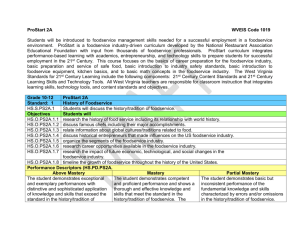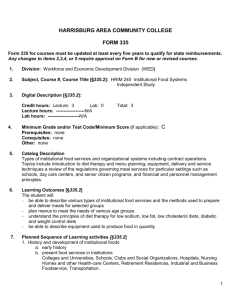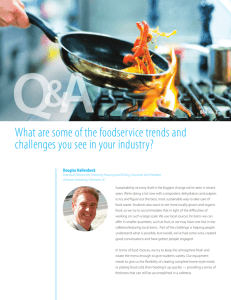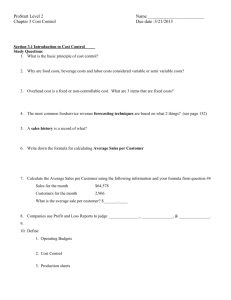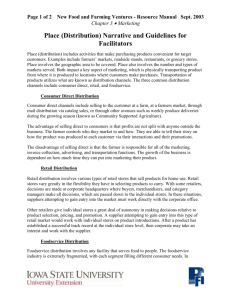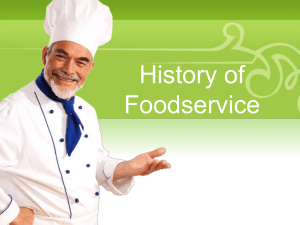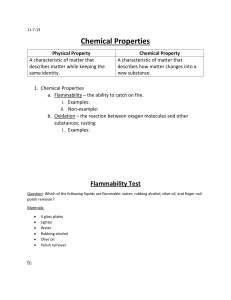1019 ProStart 2A IG - Career and Technical Education
advertisement
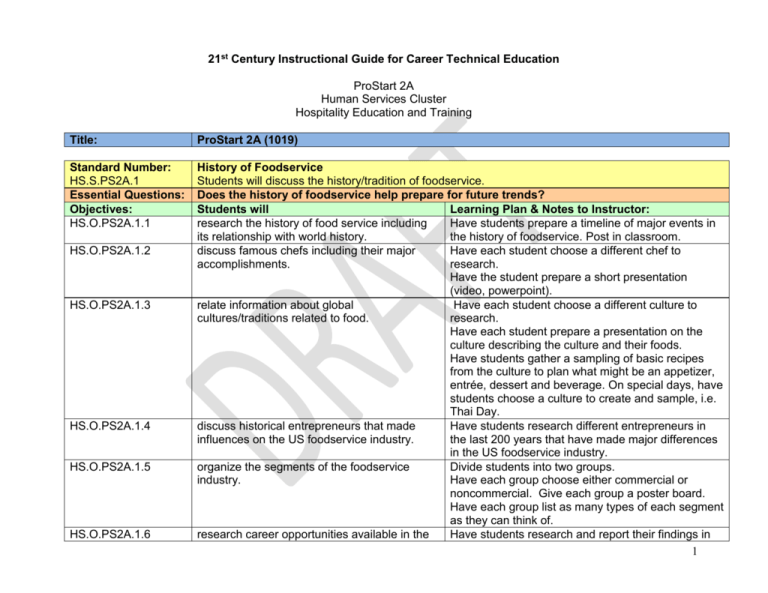
21st Century Instructional Guide for Career Technical Education ProStart 2A Human Services Cluster Hospitality Education and Training Title: ProStart 2A (1019) Standard Number: HS.S.PS2A.1 Essential Questions: Objectives: HS.O.PS2A.1.1 History of Foodservice Students will discuss the history/tradition of foodservice. Does the history of foodservice help prepare for future trends? Students will Learning Plan & Notes to Instructor: research the history of food service including Have students prepare a timeline of major events in its relationship with world history. the history of foodservice. Post in classroom. discuss famous chefs including their major Have each student choose a different chef to accomplishments. research. Have the student prepare a short presentation (video, powerpoint). relate information about global Have each student choose a different culture to cultures/traditions related to food. research. Have each student prepare a presentation on the culture describing the culture and their foods. Have students gather a sampling of basic recipes from the culture to plan what might be an appetizer, entrée, dessert and beverage. On special days, have students choose a culture to create and sample, i.e. Thai Day. discuss historical entrepreneurs that made Have students research different entrepreneurs in influences on the US foodservice industry. the last 200 years that have made major differences in the US foodservice industry. organize the segments of the foodservice Divide students into two groups. industry. Have each group choose either commercial or noncommercial. Give each group a poster board. Have each group list as many types of each segment as they can think of. research career opportunities available in the Have students research and report their findings in 1 HS.O.PS2A.1.2 HS.O.PS2A.1.3 HS.O.PS2A.1.4 HS.O.PS2A.1.5 HS.O.PS2A.1.6 HS.O.PS2A.1.7 HS.O.PS2A.1.8 Standard Number: HS.S.PS2A.2 Essential Questions: Objectives: HS.O.PS2A.2.1 HS.O.PS2A.2.2 HS.O.PS2A.2.3 HS.O.PS2A.2.4 HS.O.PS2A.2.5 HS.O.PS2A.2.6 foodservice industry. research the impact of future economic, technological and social changes in the foodservice industry. an executive summary. Have students define aquaculture, organic farming, hydroponic gardening and genetic engineering. Have students use the internet to research trends in foodservice and report to the class their findings. i.e. green trends. Have students complete a webquest on genetically engineered foods (see links and resources). Have students create a timeline of major changes in US foodservice. Post in classroom. timeline the growth of foodservice throughout the history of the United States. Potatoes, Grains and Pasta Students will prepare potatoes, grains and pasta. What major role does potatoes, grains and pasta play in the foodservice industry? Students will Learning Plan & Notes to Instructor: examine the selection, receiving and storing Have students create a table listing potatoes, grains, process for potatoes, grains, and pasta. and pastas. Have columns of selection, receiving and storing. Have students research how to select potatoes, grains, and pastas. Have students research what to look for in receiving and storage procedures. chart the various forms of wheat. Have students list the various types of wheat and determine the uses for each form of wheat. contrast various types of potatoes with their Have students list various types of potatoes, uses. describe their appearance, and determine the uses for each form of potato. prepare grains/legumes using a variety of Have students prepare a list of grains and legumes. recipes and cooking techniques. Have each student choose a grain or legume from the list to research. Have students find 2 recipes that uses the grain or legume of their choice. Have students share this information with the class. Have students discuss the cooking techniques from the recipes they have chosen. contrast the difference between various types Define grains and legumes. Discuss how grains and of grains and legumes. legumes are different. chart characteristics of different types of pasta. Have students research different types of pasta. 2 HS.O.PS2A.2.7 Standard Number: HS.S.PS2A.3 Essential Questions: Objectives: HS.O.PS2A.3.1 HS.O.PS2A.3.2 HS.O.PS2A.3.3 HS.O.PS2A.3.4 HS.O.PS2A.3.5 HS.O.PS2A.3.6 Have students list the different uses for each type of pasta. Have students choose a different type of pasta and find recipes to share. develop pasta recipes using various cooking techniques. Standard Accounting Practices Students will demonstrate use of standard accounting practices in foodservice operations. What is the role and relevance of proper accounting procedures in the success of a foodservice operation? Students will Learning Plan & Notes to Instructor: interpret key accounting terminology used in Have students define key accounting terms from the foodservice operations. text. Discuss each term relative to a restaurant business. calculate cost of sales using opening and Discuss what cost of sales means to a business. closing inventory data. Give students the formula opening inventory + purchases closing inventory =cost of sales. Demonstrate calculating the cost of sales. Have students calculate several problems figuring cost of sales. demonstrate double entry accounting used in Give students an overview of double entry foodservice operations. accounting explaining for every debit there is a credit and that each type of account has a balance side. Demonstrate double entry accounting t accounts f or transactions relative to a foodservice operation. Have students then practice double entry accounting transactions. demonstrate use of common accounting Have students analyze information from various practices in foodservice operations. financial accounting forms. interpret income statements used in Discuss the purpose of an income statement which foodservice operations. is to check the financial profit or loss of a business. Discuss that revenue and expenses are shown on an income statement. Revenue is money coming in and Expenses is money going out of a business. If the money coming in (revenue) is greater than money going out (expenses), there is profit. interpret balance sheets used in foodservice Discuss the setup of a balance sheet. operations. Discuss the accounting equation that 3 HS.O.PS2A.3.7 Standard Number: HS.S.PS2A.4 Essential Questions: Objectives: HS.O.PS2A.4.1 HS.O.PS2A.4.2 HS.O.PS2A.4.3 assets=liabilities + owner’s equity. Discuss that if the equation does not match, there is an error in the balance sheet. A balance sheet at the beginning of the month changes throughout the time period because assets, liabilities, and owner’s equity changes through the time period. use the balance sheet to determine assets, Discuss the function of a balance sheet which shows liabilities, and owners equity. the beginning balances of assets (what you own), liabilities (what you owe) and owner’s equity (what the worth of the business is). Have students analyze the information on a balance sheet. Service Techniques in Food Service Operation Students will quality service techniques in the foodservice operation industry. Does quality service influence future success in foodservice operations? Students will Learning Plan & Notes to Instructor: discuss the duties and responsibilities of Have students define maitre hotel, headwaiter, traditional service staff members. captain, front waiter and apprentice. Have students discuss what each of these staff members’ responsibilities are. describe the differences between American, Discuss with students that service styles depend on French, English, Russian, and quick service. men, theme, décor, and level of formality. Have students research a theme style restaurant on the internet. Have them create a poster showing theme, décor, and formality of the restaurant to share. Have students create a chart listing American, French, English, Russian and quick service. On the chart, list the service elements that make each style of service. explain the specific uses for the different types Have students list butter knife, fish knife, steakknife, of dining utensils. dinner fork, salad fork, fish fork, cake fork, snail fork, lobster fork, oyster fork, soup spoon, teaspoon, sauce spoon, coffee spoon, expresso spoon, sundae spoon, grapefruit spoon, pastry tongs, cake server, pie server, snail tongs, shell crackers, dinner plate, 4 HS.O.PS2A.4.4 HS.O.PS2A.4.5 HS.O.PS2A.4.6 HS.O.PS2A.4.7 HS.O.PS2A.4.8 HS.O.PS2A.4.9 Standard Number: HS.S.PS2A.5 Essential Questions: Objectives: salad plate, bread plate, soup place, tureen, snail plate, sauce boat, finger bowl and glassware. For each of these, have students explain their purpose. Demonstrate how to use these utensils. Have various dining utensils available for students to practice using. demonstrate tableside preparation techniques. Discuss how to correctly handle utensils when serving. Have students prepare a poster on the Do’s and Don’ts of proper tableside techniques. Have students role play proper service techniques. explain the correct way to stock a service Have students list the elements needed in a service station. station. Have students discuss how to stock the station. demonstrate the correct way to set and clear Have students research on the internet the correct the table. way to set a table and what utensils to use. Have students diagram the proper way to set the table. Discuss the proper procedures for clearing the table. role play suggestive selling methods Have students role play service and suggestive selling of entrée specials, desserts, descriptive phrases, follow-up phrases, and guest satisfaction. describe methods used to effectively resolve Have students create a poster for the workplace customer complaints. “Review the Rules” dealing with customer complaints. Have students roleplay different scenarios to resolve customer complaints. demonstrate the proper way to present a guest Role play customer service procedures for following check, receive payment, and say goodbye to a up with a customer with bill presentation and guest. payment. Desserts and Baked Goods Students will demonstrate how to prepare desserts and baked goods. demonstrate knowledge of dessert and baked goods preparation. How do desserts and baked goods play a role in the foodservice industry? Students will Learning Plan & Notes to Instructor: 5 PS.O.PS2A.5.1 discuss the functions of basic ingredients used in preparing desserts and breads. PS.O.PS2A.5.2 chart the types of strengtheners, shortenings, sweeteners, flavorings, leaveners, and thickeners. PS.O.PS2A.5.3 differentiate between lean dough, rich dough, sour dough PS.O.PS2A.5.4 demonstrate how to bake different types of breads, pastries, pies, cakes. PS.O.PS2A.5.5 demonstrate various preparation methods of different types of cookies. PS.O.PS2A.5.6 chart how chocolate is made, tempered, and stored. PS.O.PS2A.5.7 prepare crème anglaise, pastry creams and Bavarian creams. PS.O.PS2A.5.8 outline the steps to prepare tortes and poached fruits. Give students an overview of basic baking ingredients including strengtheners, shortenings, sweeteners, flavorings, leaveners, thickeners, and liquids. Have the students discuss the function of each of the basic baking ingredients. Have the students give examples of each of these ingredients. Have students discuss the differences between lean dough, rich dough, and sour dough and give examples of each type. Have students search for recipes of different types of breads, pastries, pies, and cakes. Have the class choose recipes for preparation. Have students prepare a list of ingredients, equipment and utensils needed. Have students calculate yield. Have students prepare the recipes. Have students research the seven methods of making cookies and give examples of cookies for each method. Have students prepare cookies using the seven methods of making cookies. Have students research how chocolate is made. Have students define tempering. Have students describe the procedure for storing chocolate. Have students analyze the differences between crème anglaise, pastry cream and Bavarian cream. Discuss how to prepare each type of cream. Demonstrate how to prepare each type of cream. Have students demonstrate how to prepare each type of cream. Have students research a recipe for a torte. Have students list the steps to prepare the torte from the recipe. 6 Have students list the steps for preparing poached apples. Have students research a recipe for poaching apples. Have students use various recipes to prepare common desserts. Have students evaluate their methods. Have students evaluate their product. PS.O.PS2A.5.9 prepare common desserts using various methods. Standard Number: HS.S.PS2A.6 Purchasing and Inventory Control Students will demonstrate appropriate purchasing and inventory control procedures. demonstrate knowledge of purchasing and inventory control. What is the value of purchasing and inventory control to the success of a foodservice operation? Students will Learning Plan & Notes to Instructor: explain the relationship between primary and Have students discuss what a primary source is and intermediary sources and retailers. give examples of primary sources. Have students discuss what intermediary sources are and give examples. Have students discuss what retailers are and give examples. differentiate between formal and informal Have students define formal buying, informal buying, buying and formal bidding processes. and formal bidding. discuss factors that influence food prices. Give students a list of economic factors. Have students evaluate these factors and give examples of each. Have students use gas prices to explain food price changes from the supplier through the customer’s bill at a restaurant. explain how production records influence Discuss the role of supply and demand. Discuss purchasing decisions. growing seasons, weather and climate changes, and politics influence prices and purchasing decisions. Have students research products that have risen in price to determine causes. discuss the criteria for selecting appropriate Have students define reputable. suppliers. Have students get into groups to make a list of things 7 Essential Questions: Objectives: HS.O.PS2A.6.1 HS.O.PS2A.6.2 HS.O.PS2A.6.3 HS.O.PS2A.6.4 HS.O.PS2A.6.5 HS.O.PS2A.6.6 discuss proper receiving, storing, and issuing methods. HS.O.PS2A.6.7 differentiate between perpetual and periodic inventory methods. HS.O.PS2A.6.8 review the steps of purchasing. HS.O.PS2A.6.9 analyze control of inventory. HS.O.PS2A.6.10 demonstrate how to write purchase specifications and purchase orders. that can go wrong when ordering. Have students also make a list of services suppliers might provide. Bring groups together to make a class list. Have students analyze the list to determine what makes a good supplier and why? Have students analyze receiving, storing, and issuing. Have students divide into three groups. One group will choose receiving, etc. Each group will develop a plan (what to look for, what to remember, what methods to use, safety rules) for the area they have chosen. Have students define perpetual inventory. Have students define periodic inventory. Have students give samples where they have seen perpetual inventory or periodic inventory. (i.e. Christmas, Lowes, etc.) Have students prepare a flow chart of the 10 steps of purchasing. Discuss the value of inventory. Discuss inventory tracking. Discuss the 4 elements of a well-managed inventory. Have students define periodic inventory. Have students define par stock and reorder point. Have students define fifo. Demonstrate how to use the reorder point formula (par stock-reorder point + normal usage until delivery = amount ordred. Have students perform calculations using the reorder point formula. Review the elements of a purchase order. Give students a sample purchase order with a list of items to purchase. Give them an address on the internet, a catalog, or information needed to correctly fill out the purchase order. 8 21st Century Skills Thinking and Reasoning Skills: Personal, and Workplace, Skills: Entrepreneurship Skills: Learning Skills & Technology Tools Teaching Strategies Culminating Activity 21C.0.9Student recognizes information Students will research 12.1.LS.1 needed for problem solving, cuisines and cultures can efficiently browse, search using Internet sites to and navigate online to access identify traditions for foods relevant information, evaluates and cultural evolvement. information based on credibility, Students will incorporate social, economic, political this study into a and/or ethical issues, and PowerPoint Presentation. presents findings clearly and persuasively using a range of technology tools and media. 21C.O.9Student draws conclusions Students will analyze 12.2.LS.2 from a variety of data sources financial documents to to analyze and interpret determine and inventories systems. to develop a purchasing plan. 21C.O.9-12. Student demonstrates Student will develop a 3.LS3 ownership of his/her learning portfolio of learning and by setting goals, monitoring work experiences and adjusting performance, throughout the ProStart extending learning, using what program. he/she has learned to adapt to new situations, and displaying perseverance and commitment to continued learning. Learning Skills & Technology Tools Teaching Strategies Culminating Activity Student understands concepts Students will utilize and procedures needed for computer software and basic computer operations. hardware to complete assignments. Evidence of Success Presentations Purchasing Plan Portfolio Evidence of Success Charts, Tables, Diagrams, Flowcharts, Reports Internet research PowerPoint presentations. Culminating Assessment: 9 End of chapter activities. End of chapter assessments. WV OCTI Assessment Certification test given by NRA to the students who qualify. Completion of required hours in working toward certification to those students who choose to qualify. Participation by student teams in the Hospitality Cup competition and the National ProStart competition for those students who qualify. Links and Other Resources Related Websites: Links and Other Resources: Organizations http://careertech.k12.wv.us/pathwaystosuccess/ Pathways to Success http://careertech.k12.wv.us/West Virginia Career and Technical Education www.wvheat.org West Virginia HEAT http://www.wvhta.com/ West Virginia Hospitality and Travel Association http://www.nraef.org/prostart/ www.fcclainc.org/ www.skillsusa.org/ http://prostart.restaurant.org/ ProStart National Home Page www.acfchefs.org/ American Culinary Federation http://www.wvfarm2u.org/ Collaborative for 21st Century Appalachia http://goprostart.com/ Career and Workplace http://www.readwritethink.org/lessons/lesson_view.asp?id=1110 www.ilr.cornell.edu/library/research/subjectguides/workplacediversity.html http://www.hotel-online.com/Trends/EI/EI_ServiceChallenge.html 10 http://www.dol.gov/ U.S. Department of Labor in the 21st Century www.acinet.org America's Career InfoNet www.ajb.orgAmerica's Job Bank www.servicelocator.orgAmerica's Service Locator www.careeronestop.org CareerOneStop www.doleta.govEmployment & Training Administration http://www.jan.wvu.edu The Job Accommodation Network (JAN) http://www.bls.gov/opub/mlr/indexL.htm#Labor forceMonthly Labor Review Online: Labor Force Archives www.doleta.gov/programs/onetOccupational Information Network www.dol.gov/odep Office of Disability Employment Policy http://www.careervoyages.gov/index.cfm Career Voyages https://www.workforcewv.org/ Workforce West Virginia Scholarships https://www.nraef.org/scholarships/ http://www.wvhta.com/ West Virginia Hospitality and Travel Association http://www.wvtechprep.wvnet.edu/edge.htm West Virginia Earn A Degree Graduate Early (EDGE) www.nraef.org/prostart/National Restaurant Association Solutions (Educational Foundation) Professional Community http://www.fohboh.com/ Workplace Safety http://www.servsafe.com/ 11 http://www.croetweb.com/links.cfm?subtopicID=424 Hospitality - Hotel, Restaurant and Kitchen Safety Entrepreneurship www.entrepreneur.com/startingabusiness/businessideas/startupkits/article73384.html http://www.wvfarm2u.org/ Collaborative for 21st Century Appalachia Sustainable Agriculture and Locally Grown Products http://www.wvfarm2u.org/ http://www.farmtotablenm.org/ Culinary Reference www.foodreference.com/ www.foodreference.com/html/recipecontests.html www.foodnetwork.com www.khake.com www.epicurious.com www.restaurant.org/business/sites_food.cfm www.topsecretrecipes.com www.whfoods.com www.menupages.com Curriculum and Lesson Planning http://www.cafemeetingplace.com/ http://www.hotel-online.com/Trends/EI/EI_ServiceChallenge.html http://www.doe.in.gov/octe/facs/nutritionwell.html#resources Indiana CTE Resources 12 http://missouricareereducation.org/curr/cmd/facsG/NutriWell/index.html Missouri Resources http://www.intel.com/education/tools/index.htm Intel Thinking Tools www.uen.org/ Utah Education Network Global Concerns http://www.gamesforchange.org/channels/poverty Select for environmental and global nutrition concerns http://dnafordinner.blogspot.com/ Genetically engineered foods http://home.earthlink.net/~spcemonk/webquest.html Nutrition http://www.proquestk12.com/bulletins/08MAR/TM_PQPlatinum.shtml Food obsessions http://www.nutritiondata.com/ http://www.ces.purdue.edu/nutrition/ Nutrition database http://www.learntobehealthy.org/teens/index.aspx www.mypyramid.gov www.nutrition.gov/ www.nutritiondata.com/ www.hsph.harvard.edu/nutritionsource/ http://www.sugar.org/media/publications.asp?id=265 Councils www.wvbeef.org www.beefitswhatsfordinner.com/ www.beef.org/ 13 http://www.nationaldairycouncil.org/nationaldairycouncil/Templates/LandingPage.htm www.eatchicken.com/ www.poultryegg.org www.theotherwhitemeat.com/ www.nppc.org/ Contacts: Contacts: CTE Teachers: See CTE Directory WV Heat Coordinator: Donna Wilkes dwilkes@access.k12.wv.us OCTI Assistant Executive Director and EOCTST Coordinator: Donna Burge-Tetrick OCTI Executive Director: Gene Coulson 14

